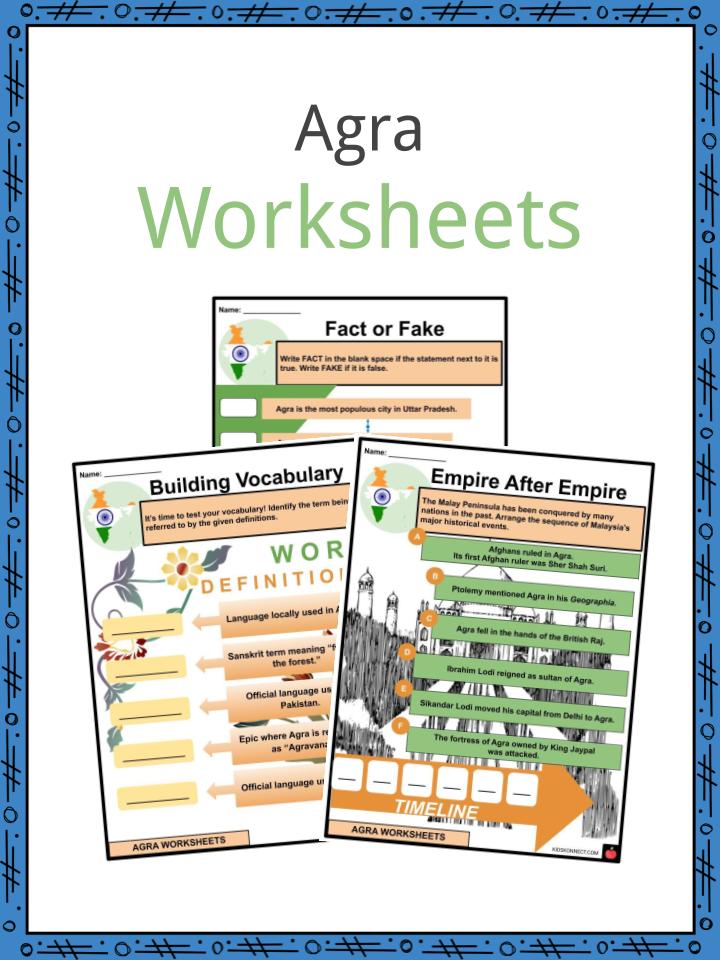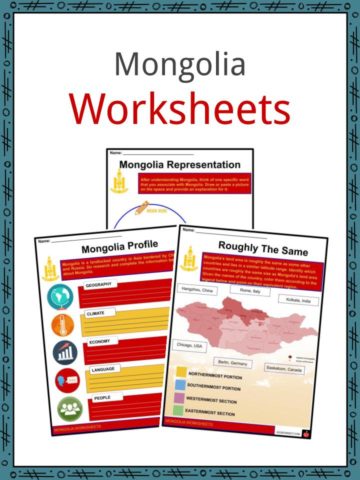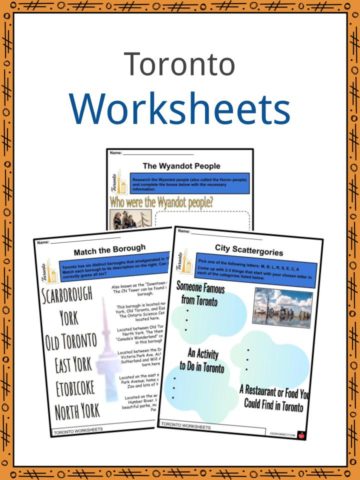Download This Sample
This sample is exclusively for KidsKonnect members!
To download this worksheet, click the button below to signup for free (it only takes a minute) and you'll be brought right back to this page to start the download!
Sign Me Up
Table of Contents
Agra is a city located in the state of Uttar Pradesh, India, residing on the banks of Yamuna river. In the state of Uttar Pradesh, Agra ranks as the fourth most populous city. In India, Agra is the twenty-fourth most populous.
See the fact file below for more information on the Agra or alternatively, you can download our 26-page Agra worksheet pack to utilise within the classroom or home environment.
Key Facts & Information
GENERAL FACTS
- Agra is located 206 kilometers south of New Delhi, India’s capital city.
- Agra is located within the state of Uttar Pradesh, which translates into Northern Province in English.
- Uttar Pradesh is the most populous state in India, with an estimated population of 200 million.
- Created on April 1, 1937, Uttar Pradesh was initially called the United Provinces of Agra and Oudh under British rule.
- Uttar Pradesh is now divided into 18 divisions and 75 districts, the district of Agra being one of them.
- The city of Agra resides on the bank of Yamuna river.
- Also known as Jumna or Jamna river.
- A tributary river, a river that is connected to a larger stream, to the Ganges river, which flows through India and Bangladesh.
- Yamuna river is the second-largest tributary river to Ganges.
- It is also the longest tributary river in India.
- The city of Agra is governed by a Municipal Corporation and known as the Agra Municipal Corporation.
- The current mayor of Agra is Naveen Jain.
DEMOGRAPHICS
- As of 2011, the city of Agra has a recorded population of 1,585,704 residents.
- The metropolitan area of Agra has a population of 1,760,285 inhabitants.
- The official language used in Agra is the official language of India: Hindi.
- An additional official language is used in Agra, given that it is a part of Uttar Pradesh, one of the states that recognizes Urdu as an official language as well.
- Urdu is the official national language and, lingua franca—a language that is widely used by different ethnic groups—in Pakistan.
- Urdu is one of the 22 constitutionally recognised official languages in India.
- Braj or Braj Bhāshā, is a Western Hindi Language that is locally used in Agra.
- The literacy rate in Agra is 73.11%, below the national average of 74%.
HISTORY
- In Mahabharata, a major epic of ancient India written in Sanskrit, the city of Agra is referred to as Agravana.
- The sanskrit term Agravana translates into “front of the forest.”
- In the epic, the Shurasena dynasty of Lord Krishna established and operated an outpost in Agravana.
- The earliest record that refers to Agravana by its modern name, Agra, dates back to the 2nd century AD, when the Greek geographer Ptolemy mentioned it in his Geographia.
- And so, as early as the 2nd century, the city of Agra could be found illustrated on the world map.
- The fortress of Agra, owned by King Jaypal, ruler of Hindu Shahi dynasty, was attacked and documented in the 11th century by the Persian Poet Mas’ūd Sa’d Salmān.
- The assault of the fortress of Agra was led by the independent ruler of the Turkic dynasty of Ghaznavids, Mahmud of Ghazni. He was successful in destroying the place, although he eventually surrendered.
- In 1080 AD, a Ghaznavid force captured Agra.
- From 1488 until 1517, Agra was a small settlement or village.
- In 1504, Sikandar Lodi was the first Sultan to move his capital from Delhi to Agra.
- Before Sikandar Lodi’s sultanate in Agra, the city was administered under the city of Bayana.
- Sikandar administered the country from Agra, and the city assumed the status of a second national capital.
- Sikandar died in 1517 and was succeeded by his son, Ibrahim Lodi, who reigned sultan until 1526.
- During Ibrahim’s sultanate, several palaces, wells, and mosques were built.
- Ibrahim was defeated at the Battle of Panipat in 1526.
- From 1540 until 1556, Afghans ruled in Agra. Its first Afghan ruler was Sher Shah Suri.
- After the rule of the Suri Empire, Agra became a capital of the Mughal Empire from 1556 until 1648.
- Agra was ruled by the Maratha Empire in the 18th Century.
- In 1803, Agra fell in the hands of the British Raj.
TOURIST DESTINATIONS
- The famous Taj Mahal is found in the city of Agra. It is a mausoleum built during the Mughal Era.
- It is located on the southern bank of the Yamuna river.
- The construction of the Taj Mahal was commissioned in 1632 by Shah Jahan, a Mughal Emperor, for his favorite wife’s tomb, Mumtaz Mahal.
- The Agra Fort is also a tourist destination in Agra, where the emperors of the Mughal Dynasty resided until the capital was shifted to Delhi in 1638. The last rulers who occupied it were the Marathas before being captured by the British forces.
- It was inscribed as a UNESCO World Heritage Site in 1983.
Agra Worksheets
This is a fantastic bundle which includes everything you need to know about the Agra across 26 in-depth pages. These are ready-to-use Agra worksheets that are perfect for teaching students about the Agra which is a city located in the state of Uttar Pradesh, India, residing on the banks of Yamuna river. In the state of Uttar Pradesh, Agra ranks as the fourth most populous city. In India, Agra is the twenty-fourth most populous.
Complete List Of Included Worksheets
- Agra Facts
- Fact or Fake
- Building Vocabulary
- Empire After Empire
- About Uttar Pradesh
- Uttar Pradesh Destinations
- Map Study
- Famous Destinations
- People From Agra
- My Agra Itinerary
- Touring Agra
Link/cite this page
If you reference any of the content on this page on your own website, please use the code below to cite this page as the original source.
Link will appear as Agra Facts & Worksheets: https://kidskonnect.com - KidsKonnect, August 3, 2020
Use With Any Curriculum
These worksheets have been specifically designed for use with any international curriculum. You can use these worksheets as-is, or edit them using Google Slides to make them more specific to your own student ability levels and curriculum standards.









